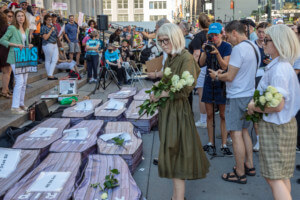[Editor’s Note: Peter L. Laurence, author of Becoming Jane Jacobs, noted on Twitter that some of Jane Jacobs’s 100th anniversary coverage mischaracterized her contributions to the field of city planning. AN reached out to Laurence for comment, and he responded with this essay.]
May 4, the centennial of Jane Jacobs’s birth, was a big day for her fans. Thanks in part to a Google doodle, Jacobs trended hard against Star Wars Day (#Maythe4thBeWithYou) and gained some new fans and readers; to the benefit of all interested in cities and urban design, sales of her 1961 classic The Death and Life of Great American Cities spiked on Amazon.
May 4 was also a field day for Jacobs scholars and students, because it was an opportunity to see how her reputation has changed over the past five or six decades and whether new scholarship in the decade following her death has made any impact on this. It has been an opportunity, in other words, to observe how Jane Jacobs is deified and demonized, and how the Gospel of Jane is now interpreted.
In at least one overarching respect, little has changed in fifty years: Jacobs, playing the biblical David, is still frequently defined in opposition to a Goliath. When her great book came out, Goliath took the form of an amorphous beast called City Planning, which was then synonymous with Urban Renewal. In the postmodern decades, it was Le Corbusier as the embodiment of modern architecture. Today, the monster is Robert Moses.
This is not new. “Bob Moses’s block-busting method” was criticized years before Jacobs wrote about it; Moses was already notorious and she didn’t need to say much about him in Death and Life. However, Moses’s shadow continues to loom over her, despite the fact that her true adversary was a leviathan composed of city halls, city planning and redevelopment agencies, real estate developers profiting from urban renewal policies, highway authorities, suburbanism, and public inertia. Among her major battles in Manhattan, Moses wasn’t behind the scheme to redevelop the West Village; and the Lower Manhattan Expressway, which received support from picketers who saw short-term gains in construction jobs, among others, was bigger than Moses and outlasted him. Fueled in part by the anger that activism took away from writing her second book, The Economy of Cities (1969), Jacobs described LoMEx as a beast that had to be killed three times, in 1962, ’65, and ’68, by which time Moses’s political power had been also fatally wounded.
Today, the Urban Renewal Administration and its regime, which she helped to kill, are long dead, and the field of city planning, which she helped to change, is a very different field than it was a half century ago. However, we glory in the story of heroes and villains. Like the forthcoming opera about Jacobs and Moses, these can be subtle and beautiful works of art that help us to remember the past and introduce its history to a new generation. But the passage of time has also distilled Moses into a mythological figure, symbolizing all top-down planning and the whole complex but largely forgotten history of postwar urban renewal itself, making it appear that urban renewal was the work of an evil individual, rather than public policy driven by market forces, racism, and widely shared desires to live in suburbs and commute into cities. (The same has been done with Le Corbusier, as if he singlehandedly invented Modernism.)
Once a dualism is constructed (e.g. Jacobs vs. City Planning/Modern Architecture/Robert Moses), certain conclusions must follow and, because this is the way dualist mythologies work, if Moses represents top-down planning, large-scale infrastructure, and urban change, then Jacobs must represent bottom-up forces, anti-development, anti-change and NIMBYism, preservation, the small scale, and the domestic. Moreover, because a dualism is necessarily reductionist, today, in an era experiencing an urban renaissance that neither city planning theorists of the 1930s nor city dwellers of the 1970s could have imagined, Moses’s villainy reflects not only the success of Jacobs’s ideas, she is blamed for the excessive accuracy of her ideas.
A great observer and theorist of urban dynamics, it was not Jacobs’s idea to use historic preservation laws to turn cities into museums; her argument for old buildings had historical and esthetic aspects, but it was primarily concerned with the low-profit and no-profit activities and affordable housing that could take place in them, and it did not exclude new construction. Jacobs opened Death and Life with something simple and “small scale” for her readers, the lyrical “sidewalk ballet,” primarily to illustrate the ways that urban design can enable non-authoritative self-policing and contribute to urban safety, the foundation for any city life; after systematically discussing sidewalks, streets, blocks, parks, neighborhoods, and urban form in increasing scales, she concluded it with something conceptually beyond even the “large scale:” a discussion of the relationship of the history of science with urban history and theory, to which she made the unprecedented contribution of applying the nascent science of complexity to the study of cities. This was decades before chaos theory and non-linear dynamics developed in scientific circles. And while today “self-organization” has become some kind of truism, Jacobs understood well enough that people also self-organize into the suburbs and into more insidious forms of social organization.
Because an analysis of Jacobs’s legacy would be incomplete without a criticism, this week we also saw Jacobs accused of being a pioneering gentrifier because her Greenwich Village home and neighborhood, which she identified as a good place to live, increased dramatically in value, most substantially after she moved away. Ironically, Jacobs was not only a pioneering theorist of the dynamics of gentrification, she was an activist against urban renewal projects specifically designed to replace ethnic, working-class “slums” with middle-class and upper-income housing in Greenwich Village and elsewhere. Although she was a harsh critic of middle-class values, she is considered by some to be too bourgeois (while, contradictorily, others cheer, “Less Marc Jacobs, More Jane Jacobs”).
Jacobs has been accused of not having enough to say about race in a treatise about urban and suburban diversity, in which she discussed discrimination, racial and economic segregation, redlining, and spoke of American society’s “tendencies toward master-race psychology.”
And she has been made out to be an advocate of deregulation and apologist for “so-called ‘urban sprawl’,” despite warning against it as early as the late 1950. But her fights with city hall did not mean she was an anarchist or libertarian; she believed in democratic government free from financial influences, well-applied regulations (including zoning) and taxes, support for mass transit and other public services, and public intervention to counteract free-market forces that threatened city diversity and vitality. She was interested in metropolitan government, but understood that great cities were already terribly difficult to govern. Speaking of a city council members’ struggle with “problems which are out of the control of everyone,” she wrote, “These are not boys sent on a man’s errand. These are men sent on a superman’s errand.”
When Jacobs finished writing Death and Life, someone observed that it was a long book and suggested that she cut it back substantially to make it easier for the public to absorb. She recoiled, stating, “My own view is that this country is full of digesters, reviewers, and summarizers, and those who do not care to read a book as long as this will get some of the drift of its ideas through those means anyhow.”
Jacobs was right about this. There are many Jacobites today, both fans and critics. However, how and why Jacobs is praised and criticized is important. This past week was often a celebration of not only of myths, but cartoons and intellectual shortcuts, among them well-worn ideological pathways to predetermined destinations. Not only do these lead to funhouse mirror portraits of Jacobs (e.g., she was a libertarian), they lead to such slogans as “More Moses, Less Jacobs,” an invitation to despotism that reflects a dangerous historical amnesia, among other forms of ignorance.
We have come a long way from the sexist condescension of Lewis Mumford’s 1962 review “Mother Jacobs’s Home Remedies.” She was right about the death and life of cities; her ideas have prevailed and endured. But rather than think that we have reached “peak Jacobs” and that the best way to advance is to circle around to the other side of a false dichotomy, her ideas should be criticized for not going far enough in practice and theory. Her activism to improve car-dominated urbanism and suburban thinking, for example, must continue; there is no sidewalk ballet where there are no sidewalks. Meanwhile, the questions and theoretical paradoxes in her writing must be explored: How do we reconcile Jacobs’s concerns for residential tenure and neighborhood stability in a highly mobile society? How do we manage gentrification and other “self-destructions of diversity” in a capitalist framework? How do we challenge still prevalent forms of racial and economic segregation? How do we reform the governance of great cities? How do we advance cities in an age where nineteenth-century nationalism is still a prevailing ethos? How do we create new forms of knowledge about cities with complexity science without falling into the trap of scientific positivism that ensnared early modernists?
There are many good ways to celebrate and criticize Jane Jacobs. Cartoons and slogans aren’t the best ways—unless perhaps these include “More Jacobs, fewer slogans” or “Fewer slogans, more questions.”
Peter L. Laurence is the author of Becoming Jane Jacobs and director of graduate studies and associate professor of architectural and urban history, theory, and design at Clemson University School of Architecture.










